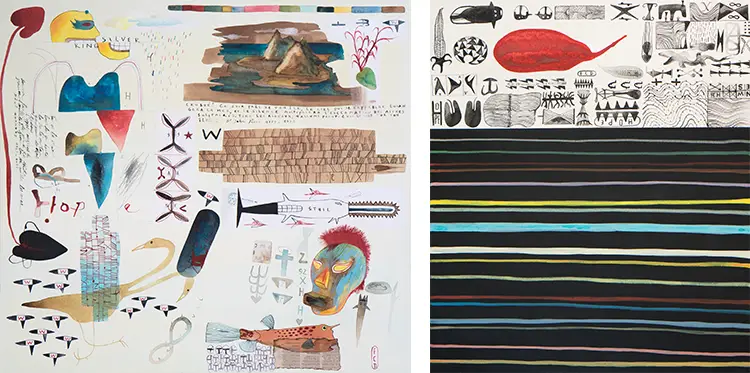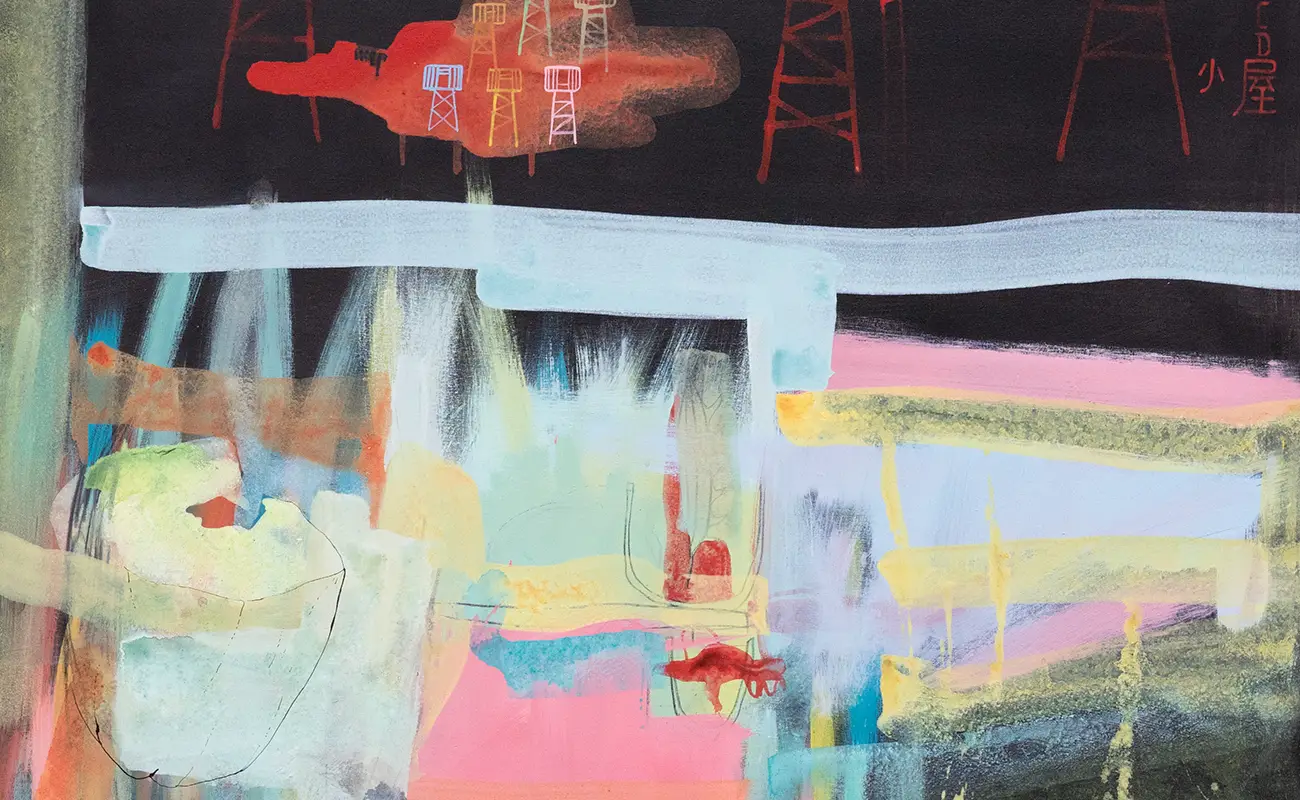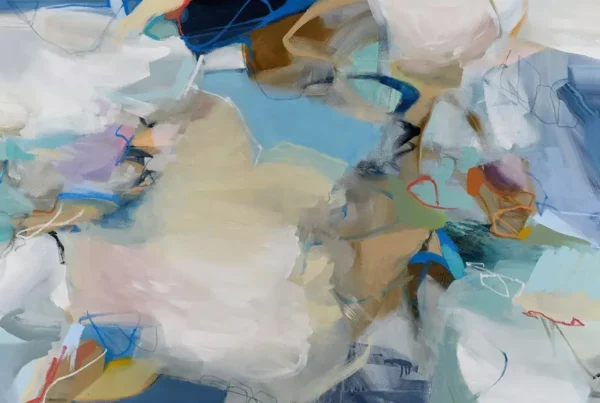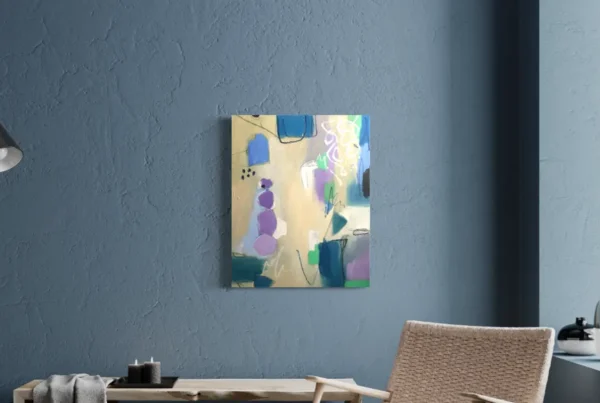“My first project is simply to see my work spread outside of my island — it’s a good way to talk about her.”
Ancestry in the Open Air
Stéphane Foucaud’s artistic universe emerges from a convergence of heritage, environment, and experimentation. Raised in New Caledonia and steeped in the traditions of tribal life, Foucaud’s practice channels the spiritual and symbolic depths of Kanak culture while embracing the eclecticism of his Creole lineage. This blend of cultural influences feeds into a visual lexicon that feels both ancient and urgently contemporary. Foucaud does not present his work as a static homage to identity, but rather as an ever-shifting conversation between ancestral echoes and modern impulses. His approach to art is as fluid as his medium, rooted in autobiography yet committed to a broader cultural resonance.
What began as an autodidactic dive into comic drawing during high school eventually evolved into a multidisciplinary practice, sparked by his academic journey through university studies in plastic arts. This period of exploration unlocked a wide array of materials and forms for Foucaud. Painting, in particular, offered the elasticity he sought—a space where personal mythologies and collective iconographies could coexist. Over time, his work drifted away from traditional easel painting, embracing flat surfaces and more gestural approaches. The artist now paints in what he calls an open space—his carport—frequented by curious neighbors and wandering cats, a setting that mirrors the accessibility and porousness of his art.
Foucaud’s studio setup reflects the spontaneous and inclusive spirit of his creative process. Distractions aren’t so much obstacles as they are part of the environment he thrives in. His workspace does not demand stillness or isolation. Instead, it’s a fluid area where the noise of the world seeps into the canvas. This openness translates into the medium he currently favors: a liquid form of acrylic paint, almost watercolor-like, enriched with unconventional materials like walnut brine, Chinese ink, and pencil. These choices reflect his ongoing interest in textures and the organic behaviors of materials, reinforcing his desire to create artworks that seem alive—marked not just by intention, but also by accident and alchemy.
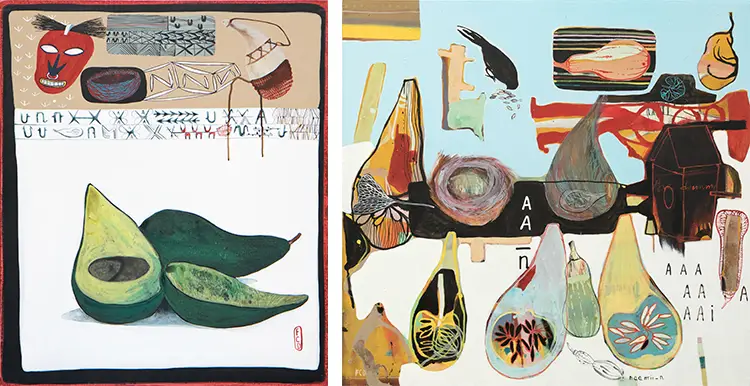
Stéphane Foucaud: Mapping the Invisible
Foucaud’s visual vocabulary is a complex interplay of language, history, and abstraction. His paintings resemble speculative cartographies—dense and symbol-laden spaces where knowledge systems both clash and coalesce. Drawing inspiration from ethnographic sources, outsider art, and the aesthetics of maps, his compositions unravel like visual manuscripts. They do not offer a linear story but rather suggest a field of interpretation, an archive waiting to be read. Masks, animals, anatomical fragments, and geographic symbols sit alongside glyphs, ideograms, French idioms, and English phrases. The resulting works feel like coded transmissions, their meaning elusive but intuitively resonant.
This signature style owes much to Foucaud’s deep respect for artists such as Antoni Tàpies and Cy Twombly, whose works similarly blur the lines between writing and painting, matter and metaphor. Yet, his aesthetic also bears traces of Oceanic graphic traditions—stylized, abstract, and ceremonial—and occasionally evokes parallels with Basquiat’s visual urgency. Foucaud’s work resists realism and avoids pure representation. What interests him instead is the residual imprint of culture, the trace left behind by belief, ritual, and story. In this sense, his paintings operate as spiritual texts, written not with words but with images that remember what language sometimes forgets.
Despite the density of his compositions, Foucaud often employs a flat illustrative style that conceals intricate layering beneath. His colors lean toward the organic—earthy browns, muted greens—interrupted by bursts of acidic vibrancy. This creates a tension between surface simplicity and underlying complexity, encouraging the viewer to look again and again. The tactile nature of his work—surfaces that resemble fabric, bark, or aged paper—contributes to its hybrid identity: part painting, part artifact, part poetic code. It’s within these contradictions that Foucaud’s artistic power truly resides.
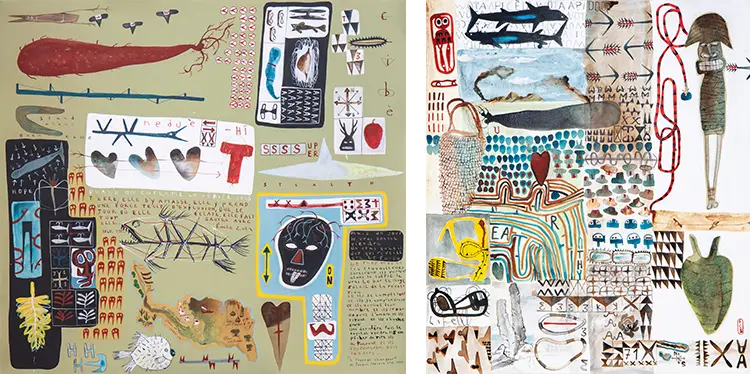
Art as a Cryptic Conversation
At the heart of Foucaud’s creative practice is a fascination with language—not only the written word, but symbolic and visual communication across time and culture. His works pulse with cryptic vitality, inviting viewers to engage with them like lost messages or half-remembered dreams. Each composition becomes a site of potential meaning, open to individual interpretation. Rather than offering a single viewpoint, Foucaud creates spaces where memory, myth, and speculation intermingle. His paintings are not merely viewed; they are read, questioned, and emotionally decoded.
One particular piece that holds deep personal meaning for Foucaud exemplifies this approach, though he speaks of it more in terms of intent than title. This painting, infused with dense layering and delicate washes, acts as a visual love letter to his island home—New Caledonia. It captures not only geographical markers but cultural imprints, turning a personal narrative into a shared visual experience. The work vibrates with the tension of distance and belonging, offering a sensory memory of place through texture, symbol, and color.
Though his techniques are rooted in tradition, Foucaud never ceases to experiment. Acrylic paint remains central to his practice because of its adaptability and rapid drying time, but he pushes its limits—diluting it to mimic watercolor, combining it with ink and organic stains, and interweaving drawing elements throughout. This fluidity echoes the themes of his work: nothing is fixed, everything is in transition. Each surface becomes a dialogue between control and chaos, narrative and enigma. It is through this aesthetic fluidity that Foucaud continues to shape a language that is entirely his own.
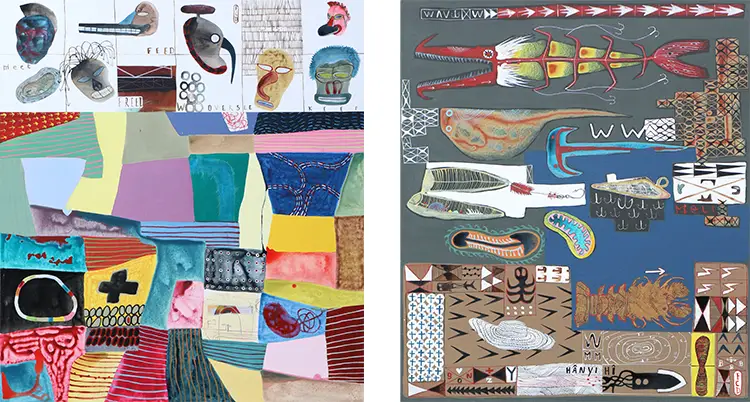
Stéphane Foucaud: From Island Echoes to Global Voices
The future for Stéphane Foucaud is not framed by fame or market recognition, but by a more intimate ambition: to carry the voice of his island beyond its shores. He views the diffusion of his work outside New Caledonia not as a career milestone, but as a cultural gesture—a way to speak about his homeland through visual language. For Foucaud, painting becomes a form of storytelling that transcends geography, offering others a glimpse into the soul of a place often misunderstood or overlooked. His dream is for this dialogue to reach broader audiences, creating space for stories that originate far from the centers of the art world.
This vision is grounded not in spectacle but in sincerity. Foucaud does not seek to universalize his experience but to share it with openness and precision. His artistic voice is not amplified by volume but by depth, drawing viewers into complex compositions that ask for time and contemplation. In this sense, he does not merely export his art; he invites others to enter into its world. This form of exchange is slow, deliberate, and profoundly human, rooted in respect for both origin and interpretation.
While Foucaud continues to develop new projects, his primary commitment remains to the integrity of his artistic language. Whether through new experiments with medium or collaborations across borders, he envisions his practice as an ongoing evolution—one that holds space for memory, invention, and the invisible ties that connect all forms of expression. His work is a living archive, one that doesn’t just reflect his past but charts possible futures—maps without borders, languages without grammar, and stories without end.
